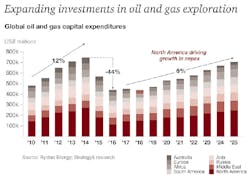Being surprised by an act of civility in politics or your kids actually doing their chores without being asked? We all want that. But no one hopes to get blindsided by shifting industrial trends, possibly missing out on a new revenue stream or business opportunity.
That's why identifying the hot companies barreling through the ranks of the IW U.S. 500 can give you critical insights into where investments should be made, or at the very least, substantiate the business models and methodologies to emulate.
This year, the dominant force should come as no surprise. Fueled by surging oil prices and sinking supplies, petroleum and coal companies account for 40% of the top 20, holding five of the top six spots. With demand steady and supply shaky, the search to unearth new fossil fuel reserves has ignited major capital expenditures. After a precarious dip from 2015 to '16, capex has rebounded in a big way, being driven by North America, a trend that Rystad Energy projects will continue through 2025.
President Trump opening up more of the continental shelf to offshore drilling, combined with failed states such Venezuela dropping production, seem like obvious reasons for the shift. Another explanation, one that may signal who could be on next year's list, is the growing digital transformation movement. Oil being a fixed resource, it makes sense to retrieve it in the most efficient way. As in a factory, closely monitoring equipment to avoid shutdowns, or calling on artificial intelligence, will be crucial to creating ways to spend less time and energy out in the Permian Basin or out in the Gulf of Mexico.
PwC oil and gas strategists say the use of new digital tools will help future-proof the industry.
In Oil and Gas Trends 2018-19, they write: Now is the time to transform operations by leveraging advanced digital technology to drive efficiencies and to open up new opportunities. Doing so might involve so-called digital twins (virtual simulations of assets) that can improve the efficiency of predictive maintenance. It might also take the form of using drones to inspect offshore platforms, which reduces workers’ exposure to hazardous tasks; data analytics to optimize production and reserves; or other new processes and practices. Oil and gas companies need to drive this innovation across their businesses.
And that's good news for all of industry, as the more big companies find reliable ways to leverage the Industrial Internet of Things and other modern innovations, the more likely those practices will trickle down to other industries. If that does happen, it shouldn’t come as a surprise if the meager representation from electronics and instrumentation makers this year get a nice boost headed into the 2020s.
Don't say we didn’t warn you.
About the Author
John Hitch
Senior Editor
John Hitch writes about the latest manufacturing trends and emerging technologies, including but not limited to: Robotics, the Industrial Internet of Things, 3D Printing, and Artificial Intelligence. He is a veteran of the United States Navy and former magazine freelancer based in Cleveland, Ohio.
Questions or comments may be directed to: [email protected]
